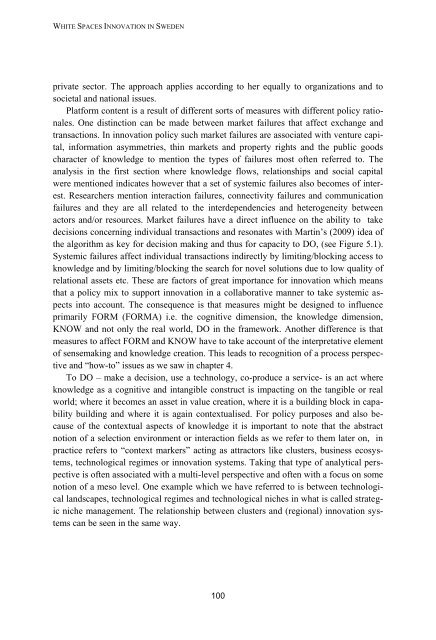White Spaces Innovation in Sweden - Innovation policy for ... - Vinnova
White Spaces Innovation in Sweden - Innovation policy for ... - Vinnova
White Spaces Innovation in Sweden - Innovation policy for ... - Vinnova
You also want an ePaper? Increase the reach of your titles
YUMPU automatically turns print PDFs into web optimized ePapers that Google loves.
WHITE SPACES INNOVATION IN SWEDENprivate sector. The approach applies accord<strong>in</strong>g to her equally to organizations and tosocietal and national issues.Plat<strong>for</strong>m content is a result of different sorts of measures with different <strong>policy</strong> rationales.One dist<strong>in</strong>ction can be made between market failures that affect exchange andtransactions. In <strong>in</strong>novation <strong>policy</strong> such market failures are associated with venture capital,<strong>in</strong><strong>for</strong>mation asymmetries, th<strong>in</strong> markets and property rights and the public goodscharacter of knowledge to mention the types of failures most often referred to. Theanalysis <strong>in</strong> the first section where knowledge flows, relationships and social capitalwere mentioned <strong>in</strong>dicates however that a set of systemic failures also becomes of <strong>in</strong>terest.Researchers mention <strong>in</strong>teraction failures, connectivity failures and communicationfailures and they are all related to the <strong>in</strong>terdependencies and heterogeneity betweenactors and/or resources. Market failures have a direct <strong>in</strong>fluence on the ability to takedecisions concern<strong>in</strong>g <strong>in</strong>dividual transactions and resonates with Mart<strong>in</strong>‟s (2009) idea ofthe algorithm as key <strong>for</strong> decision mak<strong>in</strong>g and thus <strong>for</strong> capacity to DO, (see Figure 5.1).Systemic failures affect <strong>in</strong>dividual transactions <strong>in</strong>directly by limit<strong>in</strong>g/block<strong>in</strong>g access toknowledge and by limit<strong>in</strong>g/block<strong>in</strong>g the search <strong>for</strong> novel solutions due to low quality ofrelational assets etc. These are factors of great importance <strong>for</strong> <strong>in</strong>novation which meansthat a <strong>policy</strong> mix to support <strong>in</strong>novation <strong>in</strong> a collaborative manner to take systemic aspects<strong>in</strong>to account. The consequence is that measures might be designed to <strong>in</strong>fluenceprimarily FORM (FORMA) i.e. the cognitive dimension, the knowledge dimension,KNOW and not only the real world, DO <strong>in</strong> the framework. Another difference is thatmeasures to affect FORM and KNOW have to take account of the <strong>in</strong>terpretative elementof sensemak<strong>in</strong>g and knowledge creation. This leads to recognition of a process perspectiveand “how-to” issues as we saw <strong>in</strong> chapter 4.To DO – make a decision, use a technology, co-produce a service- is an act whereknowledge as a cognitive and <strong>in</strong>tangible construct is impact<strong>in</strong>g on the tangible or realworld; where it becomes an asset <strong>in</strong> value creation, where it is a build<strong>in</strong>g block <strong>in</strong> capabilitybuild<strong>in</strong>g and where it is aga<strong>in</strong> contextualised. For <strong>policy</strong> purposes and also becauseof the contextual aspects of knowledge it is important to note that the abstractnotion of a selection environment or <strong>in</strong>teraction fields as we refer to them later on, <strong>in</strong>practice refers to “context markers” act<strong>in</strong>g as attractors like clusters, bus<strong>in</strong>ess ecosystems,technological regimes or <strong>in</strong>novation systems. Tak<strong>in</strong>g that type of analytical perspectiveis often associated with a multi-level perspective and often with a focus on somenotion of a meso level. One example which we have referred to is between technologicallandscapes, technological regimes and technological niches <strong>in</strong> what is called strategicniche management. The relationship between clusters and (regional) <strong>in</strong>novation systemscan be seen <strong>in</strong> the same way.100
















